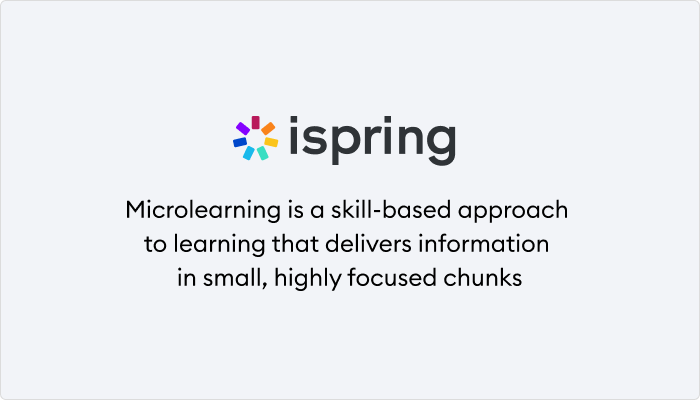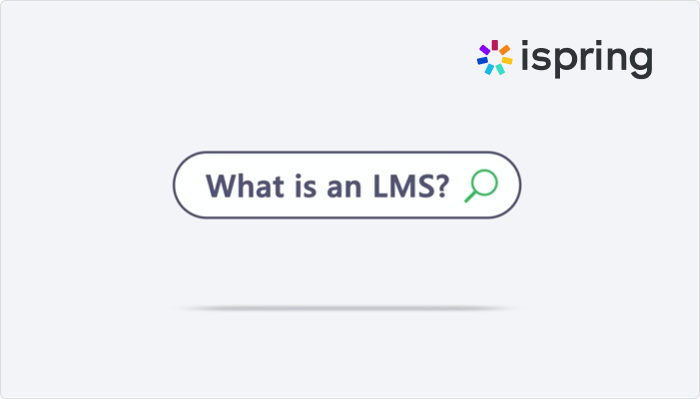Just in Time Training — An Implementation Guide

Gone are the days of regularly scheduled programming. Nowadays, we watch TV on demand, we use our cell phones to order cabs right to our doorsteps, and, thanks to mobile devices, we can even learn more flexibly, taking e-courses on the go. As the world becomes increasingly “on-demand,” the attitude of companies to employee training is also changing. Employees expect to have information at their fingertips, and businesses need quick training with big results. That’s where just in time training (JIT training) comes in.
This article offers an in-depth guide for companies looking to implement a just in time training model in their business.
What Is Just in Time Training?
Just in time training is an approach to learning and development that promotes need-related training. The JIT concept comes from Toyota’s just-in-time production system that favors manufacturing when needed (rather than ahead of time), to reduce waste and boost efficiency. Just in time learning follows the same rule: it’s about learning new skills at the point of need, rather than studying a lot of information (some of which may not be relevant to a particular employee), “just in case.”
JIT learning offers a more flexible training approach that acknowledges that not all employees need the same training at the same time. Why? Employees are busy. Long classroom sessions or hour-long eLearning courses simply don’t fit their lifestyles. With just in time training, they can access the knowledge they need, anytime, anywhere.
Who Is the Target Audience of Just in Time Training?
Everyone. Having said that, JIT training is particularly effective for employees who don’t spend their day in front of a computer: sales representatives, construction staff, healthcare professionals, and field workers.
What Is Just in Time Content?
This content is developed with the principles of microlearning and mobile learning in mind. It should be short, targeted, and cover just one specific training need. It can be formatted as short videos, targeted eLearning micro-courses, or job aids. One of the most important criteria is the speed the learner can find and access it.
For a mini-lesson on microlearning, check out this informative video.
Advantages of Just in Time Training
Just in time training brings considerable benefits to your business. In the infographic below, we highlight seven of the biggest advantages.
| #1 Accessibility | Mobile learning and microlearning make JIT training more accessible, so employees can stay updated with best practices. |
| #2 Maintenance | Bite-sized pieces of learning content are quicker to develop and update than revising long courses. |
| #3 Performance | Easy access to up-to-date training information means employees can do their jobs better, with fewer mistakes and less disruption to others’ workflows. This directly affects the bottom line. |
| #4 Retention | Learners only need to retain the key information related to their jobs. Reduces information overload and increases knowledge retention. |
| #5 Cost and time-effective | It’s easier to train a global workforce. JITT reduces training and eLearning development costs, freeing up valuable time and resources. |
| #6 Proactivity | Learners gain confidence because they know that the information they need is readily available. They are more proactive in their learning journey. |
| #7 Quicker learning curve | We learn better when we have an immediate need. JIT training empowers employees to apply new skills, thus improving learning quality. |
Disadvantages of Just in Time Training
There’s no doubt that JIT training offers plenty of advantages, but it may not be for everyone. The infographic below outlines some possible downsides of just in time training.
| #1 Requires a significant initial investment | To implement JIT training, the business will need to invest time, resources, and money into the project. Getting the training model up and running requires tools, subject matter experts (SMEs), and training authors. |
| #2 It can be difficult to effect change in large organizations | The larger the organization, the harder it is to change the learning culture. Switching to a JIT training model takes time, patience, and perseverance, as well as a good internal marketing plan. |
| #3 Training teams need a strong grasp of learning needs | For JIT training to work, the business needs to have a sound understanding of what employees need to know, when and where they will need this information, and how to create learning content that meets those needs. This demands an in-depth needs analysis and a lot of cross-collaboration. |
| #4 Upkeep is crucial | JIT training facilitates the fast-moving nature of current businesses. In order for it to be successful, however, the business may need to invest in a dedicated team to manage this workload. |
Examples of Just in Time Training
In this section, we look at some common examples of just in time training, and the types of content that can be used to train employees on the go.
Example #1: New product release for sales reps
Sales representatives face the difficult task of staying up to speed on new products and learning the new products in a short timeframe. Just in time training enables them to answer customer queries on the spot. This builds trust, improves sales pitches, increases the likelihood of making a sale, and maintains brand consistency, especially in global teams.
Content type: An online course with a quiz
Let’s say a new product has released and you want to deliver information about it to your sales reps as soon as possible. A good way to do this is to quickly create a short course about the product.
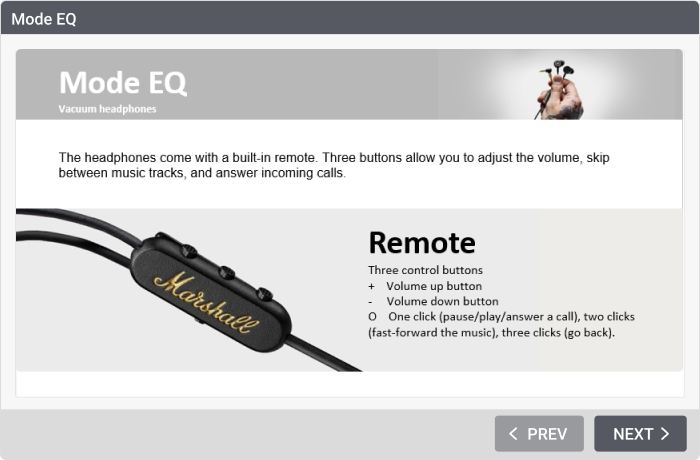
A slide from a course on Marshall headphones
To create such a course, you’ll need an eLearning authoring tool. If you have no previous experience in course development, choose easy-to-use software like iSpring Suite AI. This is a PowerPoint-based toolkit that allows you to build online courses in just minutes. You can add a quiz to the course to make sure employees understand the new information. iSpring has fourteen question types to add variety to quizzes and keep learners engaged.
Benefits of JIT online courses
Online courses are an invaluable JIT training tool for the following reasons:
- Easy access (online or via an LMS)
- Interactive and engaging format (includes media, interactions, and quizzes)
- Mobility (laptops, mobile devices, etc.)
- Straightforward training format
- Simple authoring and update
Example #2: On-the-job instructions for manual workers
Manual workers require current, reliable information to carry out hands-on activities. JIT training is especially effective for performing manual tasks, such as operating a forklift, installing new equipment, or fixing existing equipment. Workers can access step-by-step instructions in how to carry out the task, just before performing it.
Content type: A training video
Short, two-minute videos that visually demonstrate how to complete common tasks give manual workers the resources they need to perform job-related activities safely and confidently.

A screenshot from a video on operating the forklif
To create such a video, you’ll need a camera. But if you want to record a video lecture, you may just need a laptop with a webcam and iSpring Suite AI. It comes with a built-in video studio, so you can create professional videos with no prior experience. The editing suite offers a range of features to fine-tune videos by adding music, text, and other effects.
Benefits of JIT training videos
Here are a few reasons why training videos are an excellent just in time training tool:
- Higher engagement
- Visual demonstration of manual tasks speeds up the learning process.
- Increased retention—studies suggest that learners remember 80% of what they watch, but just 20% of what they read.
- Easy sharing.
- Flexibility—Can be bundled as part of more comprehensive eLearning courses.
Example #3: Job aids for ICT staff
The Information and Communications (ICT) industry is fast-changing. ICT professionals, such as software developers, require up-to-date information. Software developers have to stay on top of constant changes, such as the new software libraries for Java that are introduced on a regular basis. JIT training enables them to look up problems and compare solutions.
Content type: A screencast
When software updates or other technical issues occur, a screencast can offer a quick and effective solution. Screencasts record your computer screen, capturing everything that appears on-screen, such as text, popups, images, audio, and mouse movements. This is an ideal format for software demos, as well as tutorial videos.

A screenshot from a Java lesson
iSpring’s video studio provides all the tools needed to record watch-and-repeat software tutorials. To guide employees step by step, you can add video or audio narration and annotations.
Benefits of JIT screencasts
Screencasts pair perfectly with JIT learning for a number of reasons:
- Audio-visual learning experience
- Training relevant topics by example—e.g., walking through a step-by-step procedure in detail
- Adding a human touch to training
- Easy creation, reuse, and sharing
- Ability to absorb the information at the user’s own speed, rewatching tricky parts
Example #4: Refreshers for healthcare professionals
Healthcare staff have so much information to remember that upfront training alone sometimes isn’t enough. Due to the high-pressure nature of the industry and the logistical difficulties of training shift workers, JIT healthcare training is critical.
Just in time training gives healthcare professionals quick access to key information, such as administering dosages, side effects of drugs and treatments, and best practices for specific or rare medical issues. This is essential in an industry where on-the-job mistakes can be fatal. With new drugs and treatments appearing constantly, healthcare workers such as nursing staff can refresh their knowledge regularly and quickly find the necessary information.
Content type: Interactive activities
Interactions often use images and other visual aids. They oblige learners to interact with the content, playing an active role in the learning process. But what do we mean by “interactions”?
Here are some just in time learning examples using interactions:
- A glossary of medical terms and pharmaceutical products that medical staff can quickly flip through
- Interactive step-by-step exercises that coach employees in tasks like changing an IV bag
- Guided images to explain how medical equipment works
- Infographics to visualize cyclic processes and other core information
- FAQs that address common queries about a specific drug or treatment
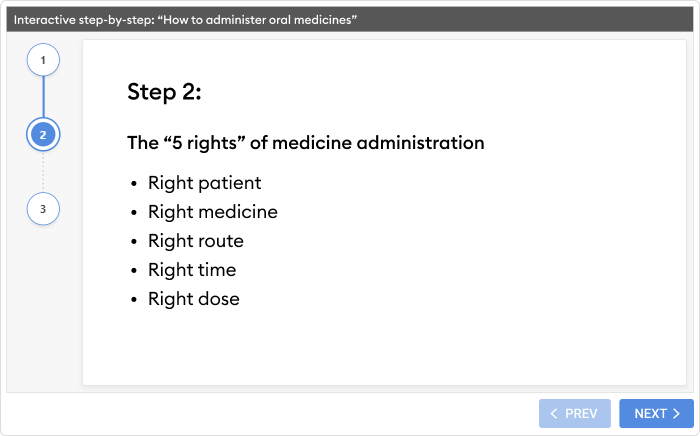
A slide from an interactive “How to administer oral medicines” lesson
iSpring Suite AI comes with twelve interactive templates for use in a huge variety of training situations: diagrams, timelines, media cards, and more.
Benefits of JIT interactive activities
Interactive activities are extremely effective in just in time training. Here are the main benefits:
- Information is broken into bite-sized chunks
- Information is more attractive to the eye
- Increased learner retention
- Fast authoring and updating
- A fast way to transfer knowledge
Use case #5: Competency training for sales and customer service teams
Let’s imagine that there is a problem with a customer. A salesperson was rude and was unable to calm the customer. The incident caused the business to lose that customer, and potentially other customers who witnessed the conflict. JIT training can be used immediately after the incident, to prevent similar situations in the future.
Content type: Dialogue simulation
A dialogue simulation is an interactive activity that imitates a real exchange with a customer or colleague.

A slide from a dialogue simulation, “Dealing with an angry customer”
Dialogue simulations harness the power of scenario-based learning to master communication skills in a safe-to-fail environment. In particular, sales and customer service teams can brush up on core competencies without the risk of damaging client relationships or brand reputation. Simulating real-world job issues reduces on-the-job mistakes and improves performance in high-pressure customer service scenarios.
iSpring Suite AI allows you to create dialogue simulations with scenarios, where each decision has a logical consequence. The toolkit has an easy-to-use editor that presents the branching scenario as a tree. You can create scenes and connect them to each other with a drag-and-drop function.
Benefits of JIT dialogue simulations
Dialogue simulations are a fantastic way to carry out just in time training, because:
- Simulations provide experiential learning for sales and customer care training.
- Strong communication skills lead to better active listening and building of rapport with customers.
- Simulations encourage employees to put themselves in the shoes of the client, fostering empathy.
- Learners receive immediate feedback from hints and tips popping up after each question, as well as detailed feedback and recommendations at the end of the simulation.
How to Apply JIT Training Successfully in the Workplace
Though just in time learning has become a hot topic recently, many companies still struggle to implement it successfully. We’ve compiled a convenient step-by-step guide to aid your organization in adopting a thriving just in time training model.
Step 1. Cultivate a learning culture in your business
The first step is to build a culture of continuous learning. A strong learning culture views training as an integral part of the enterprise that’s directly linked to business results.
Discover more about learning cultures in this short video by business expert Nigel Paine.
Step 2. Decide what information needs to be available “just in time”
Not every piece of training fits with JIT learning content. One of the most crucial (and difficult) steps in the process is determining which training resources to convert into JIT training. Doing this will require a strong needs analysis. Gather as much data as you can about your audience, the most common issues they face in the workplace, gaps in the current training process, and the training content that is most essential for employees to access on the go.
Need help carrying out an in-depth needs analysis? We’ve put together this training needs analysis template to guide you through the process.
Step 3. Design a training program
So, you’ve carried out a thorough needs analysis, and identified the key JIT training topics that you need to cover: What now? The next step is to map out a training program. Create a list of all the JIT training content topics you want to cover, and define a learning goal and a learning objective for each one.
| Topic | Learning goal | Learning objective |
| Offsite incident training | Learners will know what to do in the event of a workplace incident offsite. | Learners will be able to:
|
| First aid training | Learners will know how to administer first aid and CPR safely in the event of a first aid emergency. | Learners will be able to:
|
Step 4. Create bite-sized, relevant JIT training content
Now it’s time to create the training content. As mentioned, the quickest way to do this in-house is with an eLearning authoring tool.
When creating JIT content, follow these simple principles:
- Convert information into bite-sized chunks of content (microlearning).
- Avoid long paragraphs, and only include the information that’s absolutely necessary, so learners can find the answers right away.
- Keep it short—no longer than five minutes per training course.
- Create highly targeted content by touching on only one training need per training module.
- Focus on work-related competencies, and address competency gaps identified during the needs analysis.
- Incorporate real-world scenarios into your content to provide context (not just information), and give learners tangible opportunities to practice.
For tips on how to transform boring training into compelling courses, look no further. This webinar on scenario-based learning is for you!
Step 5. Deliver JIT training content
Once you have created training content, you need to deliver it to employees. The most common delivery method is via a Learning Management System (LMS). An LMS is a digital learning platform that organizations use to deliver, manage, and track training content. It can store all types of learning content, including eLearning courses, videos, simulations, quizzes, and digital job aids. For learners, an LMS provides an easy-to-use platform where they can access training on any device, any time they need it.
Want to know more? This video is a superb overview of what an LMS is and how it can help your business grow.
When choosing an LMS for JIT training, look for the following features:
- Responsive on multiple devices, to facilitate on-the-go learning
- A mobile learning app to provide your employees with up-to-date training, where and when they need it, even offline.
- An intuitive user portal
- Well thought-out user management features
Also read: → Best Employee Training Management and Tracking Software
Step 6. Analyze training data
After you roll out just in time training, it’s important to analyze the training data. That’s where LMS reporting comes in. Use LMS reporting features to gather data about how employees consume the content, the content they look for most often, and other key indicators that demonstrate that the training is a success.
Learning how to understand LMS data is crucial for long-term success. Come to grips with training assessment using this comprehensive guide on LMS reporting.
Also read: → LMS Benefits For Recruiters, HR, Sales and Commercial Directors—Expert Opinion
How to Measure the Success of Just in Time Training
When it comes to measuring the success of JIT learning, you may need to rethink some of the old success metrics. Here are a few ideas to help you measure the effectiveness of JIT training.
Decide what you need to measure
First, you’ll require a clear idea of what you need to measure. To achieve this, start by referring to the learning goals and desired outcomes you defined for each training course. Did the training achieve this goal? The metrics you decide on should answer this question first and foremost.
Also read: → Key Recruiting Metrics and How to Improve Them with Online Training
Using a tried and tested framework to measure training success, such as the Kirkpatrick Model, makes the evaluation process much more straightforward. The Kirkpatrick Model offers a four-level approach for evaluating training success:
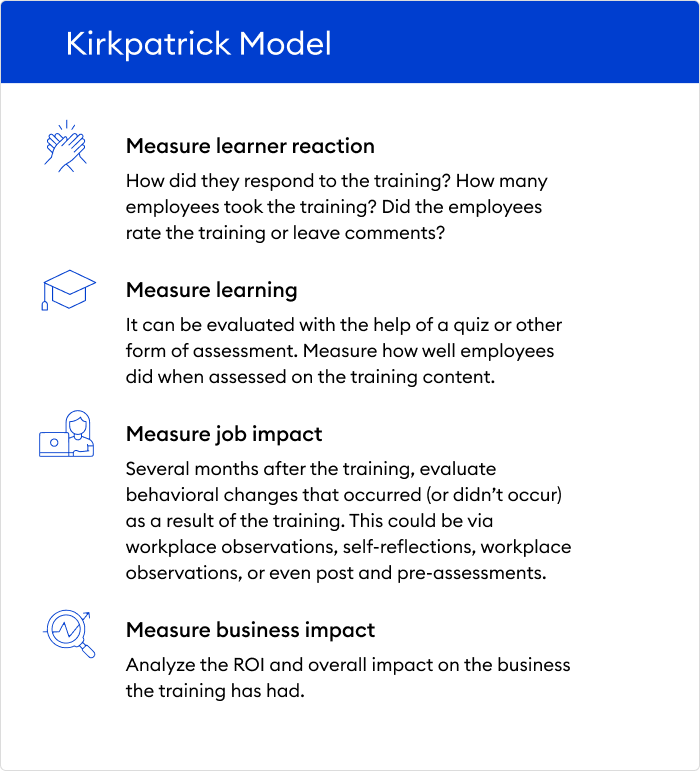
Gather feedback
To fully understand how effective employees find the JIT training, you need to ask them. Gathering this feedback can be time-consuming, but the data are invaluable. To streamline the process, set up meetings with stakeholders to gather their feedback and create surveys to send to employees.
The best way to evaluate it is measuring how the training has affected day-to-day employee performance. Let’s say your business discovered that many employees were unable to log an incident report correctly, for instance, so you delivered a JIT training course to address this skill gap. The most reliable way to measure its usefulness is to survey employees to see if the training has plugged the knowledge gap. Can employees confidently log an incident report after completing the training?
Measure team-specific ROIs
When JIT training is targeted to a specific group or team within the organization, measuring specific training-related ROIs is extremely useful. Examples of this include sales revenue, onboarding time, customer satisfaction scores, response times, and the number of escalated customer service queries.
Picture this: During the needs analysis, you notice that the customer care team has a below-average response time on questions related to a specific product. You provide the team with JIT training targeting this product and then compare the response times before and a few months after the training, to test its effectiveness.
Look at overall learning engagement
A clear indicator that your just in time learning content is proving helpful to employees is their overall learning engagement. Most LMSs have a dashboard that allows administrators to track how learners are engaging with training content. Use this dashboard to check how many employees are logging in to the LMS daily, using the content, rating it, and sharing it.
FAQ on JITT
We’ve put together a list of FAQs about just in time training, to help organizations successfully implement this training approach.
1. What is the significance of just in time learning?
Just in time learning focuses on providing easily accessible content that is highly relevant for learners. Learners are encouraged to take an active role in their learning by identifying gaps in their own knowledge and looking for the training content they need to plug them. This creates more engaged and motivated learners, who retain knowledge better.
One of the best definitions of JIT learning describes it as an “evolutionary response to the demands of a knowledge-driven and speed-oriented marketplace” (Bradenburg & Ellinger, 2003, p. 311).
2. What’s the difference between “Just in Case” and “Just in Time” Learning?
Just in case learning follows a more traditional approach. Learners undergo extensive training that covers topics that they might need to know in the future. The risk is that by the time the learner needs this information, they may have forgotten the training.
Just in time training streamlines the training process by offering immediate, easily accessible training resources that the learner can tap into when the need for the information arises. It’s a leaner-centered, more flexible training approach that avoids learner burnout and increases learning quality.
3. What is the best platform or software for just in time training?
The best just in time learning platform is a Learning Management System. A robust LMS equips organizations with the tools needed to train employees at the point of need and on any device. With this powerful piece of just in time software, your company can house training content, track learner progress, automatically manage training tasks, and scale training across the business. Learners can take full control of their training and access training courses anytime, anywhere.
Final Thoughts
As the world of training evolves, just in time training has become the method of choice—and it’s really no surprise. JIT training is the perfect way to train a global workforce, deskless employees, and staff who work in fast-paced environments where they need detailed information at their fingertips. Not only is just in time training flexible and efficient, but it’s also good for the bottom line.
Would you like to experience the benefits of an LMS to deliver just in time training to your employees? Get an iSpring LMS free 30-day trial and explore all of the features right away. Enjoy!
